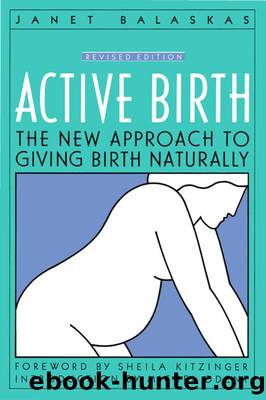Active Birth--Revised Edition: the New Approach to Giving Birth Naturally by Janet Balaskas

Author:Janet Balaskas [Balaskas, Janet]
Language: eng
Format: epub
Publisher: Harvard Common Press
It is common to feel frightened during transitionâafter all, you are about to give birth, and to see your baby for the first time! Many women feel that they cannot do it, or even that they may split apart or die. This irrational fear is sometimes not even conscious. Michel Odent calls it "physiological fear"; he believes that this fear just before giving birth has a useful function in raising the level of adrenaline. Whereas earlier in labor adrenaline could inhibit the work of the endorphins, now it has a useful function in helping to trigger the involuntary expulsive reflex of the second stage, which Odent calls "the fetus ejection reflex." He believes the attendants should not overly reassure or disturb the mother at this stage. In his observations, if she is left more or less alone to experience this fear, a quick and efficient expulsive reflex usually follows.2,3
During transition you may feel very thirsty. This unusual thirst, together with the dilation of the pupils that is common in transition, is a sign of an increase in adrenaline. It is helpful to take sips of water, or to suck on a natural spongeâwomen often experience a primitive sucking reflex during labor.
Bathe your face with a face cloth rinsed out in cold water to refresh yourself between contractions.
For some women, being completely alone in a darkened room can help to get through this stage. Others need sensitive, nonintrusive support.
Download
This site does not store any files on its server. We only index and link to content provided by other sites. Please contact the content providers to delete copyright contents if any and email us, we'll remove relevant links or contents immediately.
Periodization Training for Sports by Tudor Bompa(8096)
Bodyweight Strength Training by Jay Cardiello(7802)
Born to Run: by Christopher McDougall(7027)
Inner Engineering: A Yogi's Guide to Joy by Sadhguru(6633)
Asking the Right Questions: A Guide to Critical Thinking by M. Neil Browne & Stuart M. Keeley(5576)
The Fat Loss Plan by Joe Wicks(4755)
Bodyweight Strength Training Anatomy by Bret Contreras(4574)
Yoga Anatomy by Kaminoff Leslie(4248)
Science and Development of Muscle Hypertrophy by Brad Schoenfeld(4059)
Dynamic Alignment Through Imagery by Eric Franklin(4050)
ACSM's Complete Guide to Fitness & Health by ACSM(3936)
The Four-Pack Revolution by Chael Sonnen & Ryan Parsons(3908)
Exercise Technique Manual for Resistance Training by National Strength & Conditioning Association(3906)
Bodyweight Strength Training: 12 Weeks to Build Muscle and Burn Fat by Jay Cardiello(3876)
The Ultimate Bodybuilding Cookbook by Kendall Lou Schmidt(3851)
Yoga Anatomy by Leslie Kaminoff & Amy Matthews(3831)
American Kingpin by Nick Bilton(3710)
Yoga Therapy by Mark Stephens(3668)
Nutrition for Sport, Exercise, and Health by Spano Marie & Kruskall Laura & Thomas D. Travis(3665)
